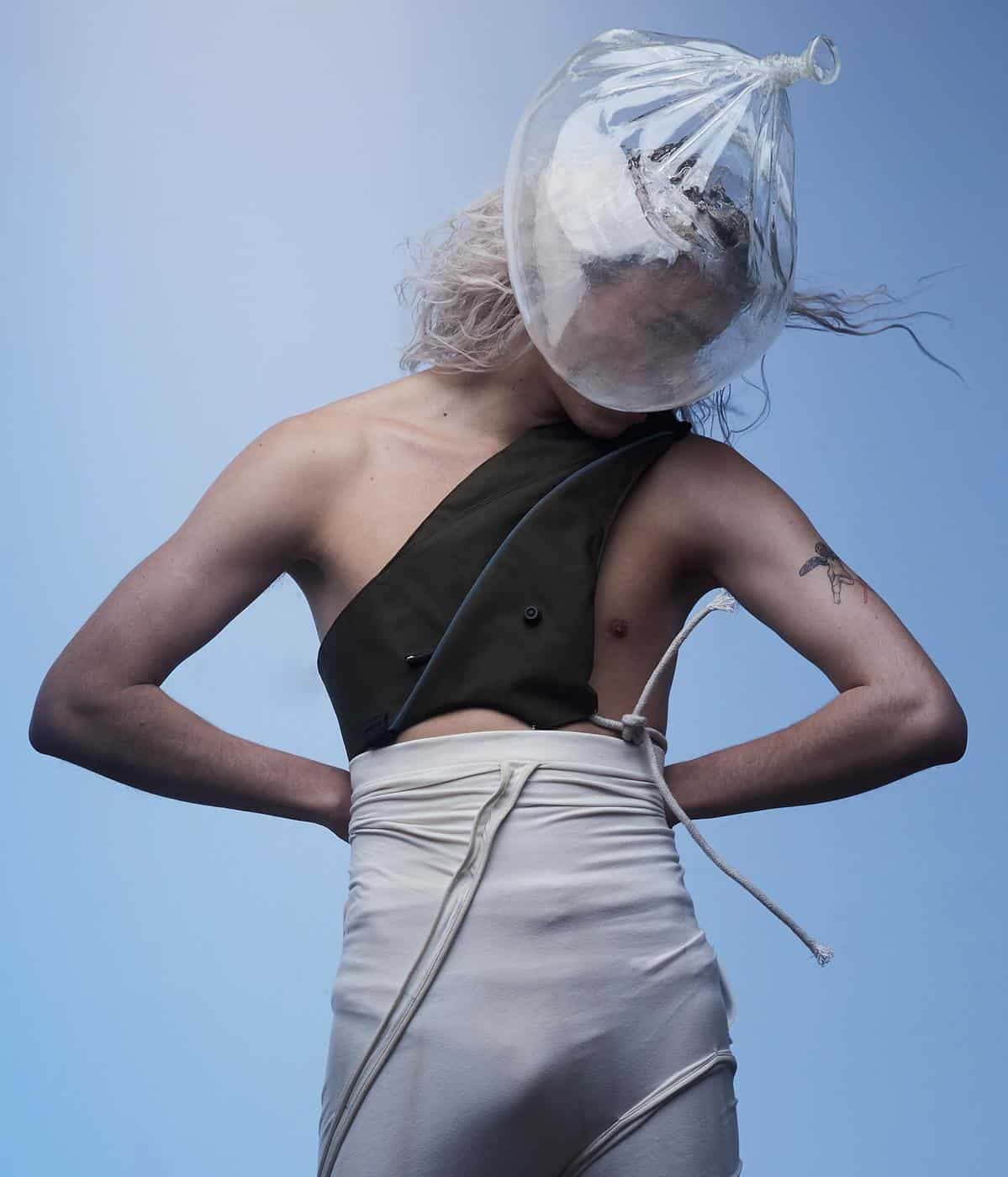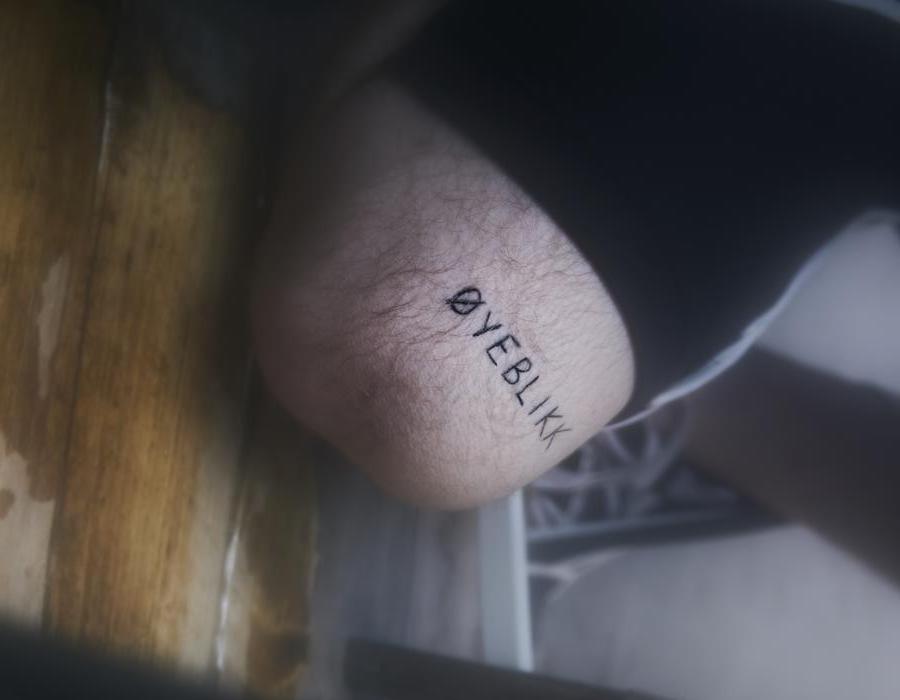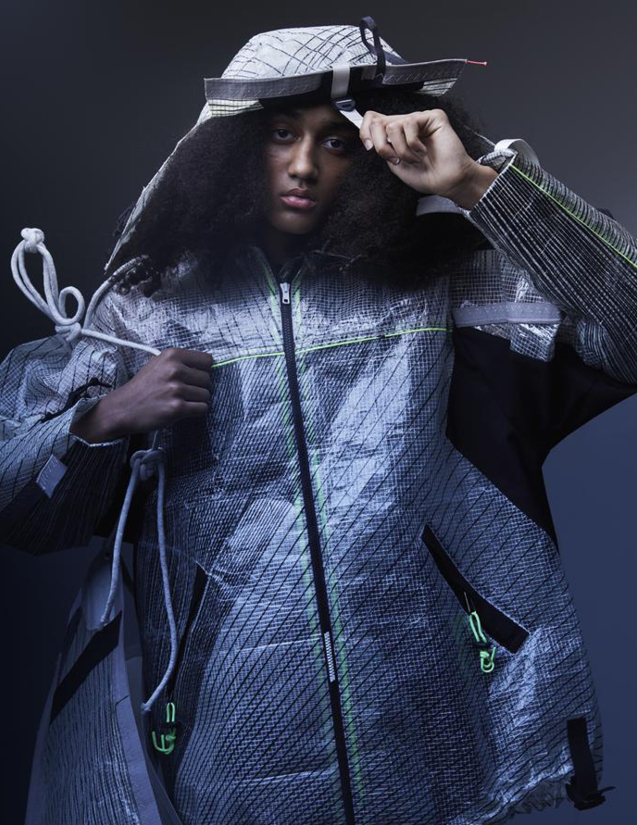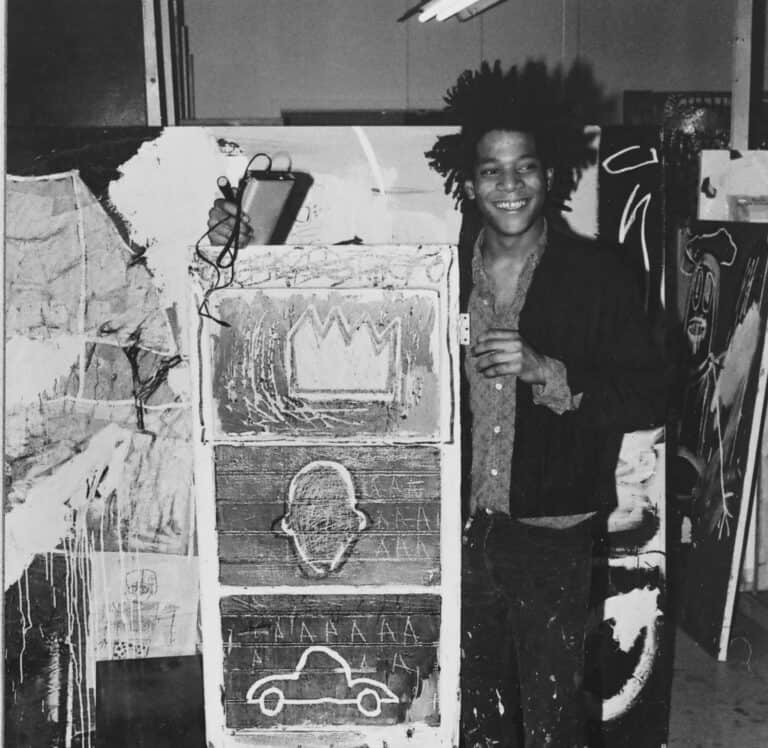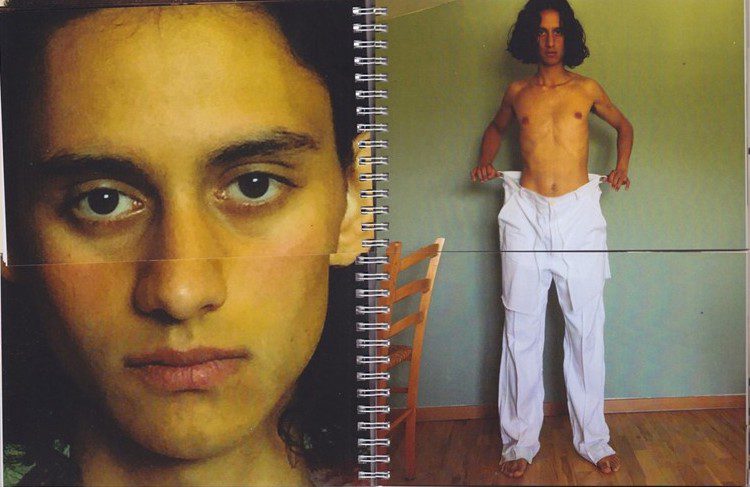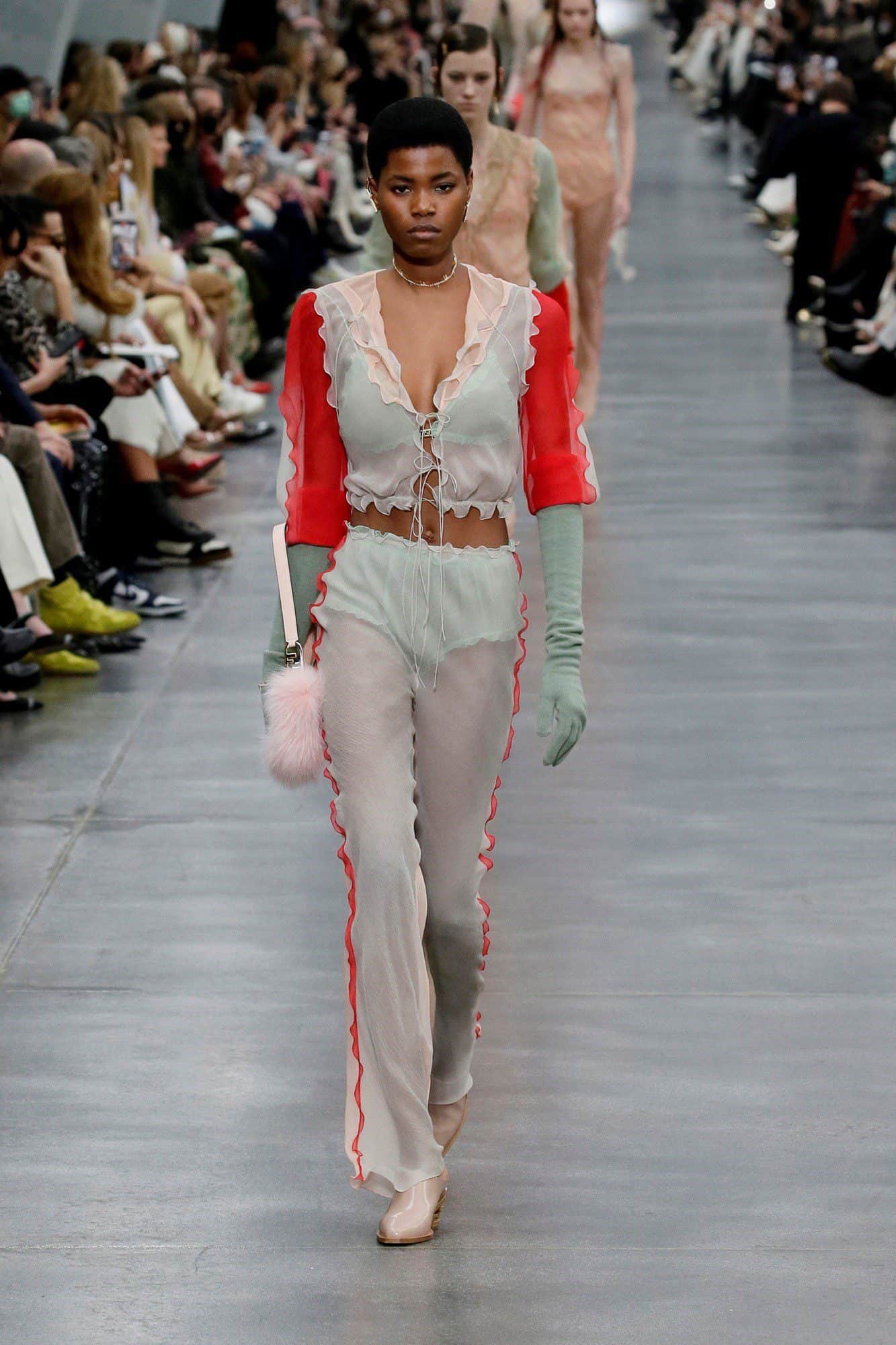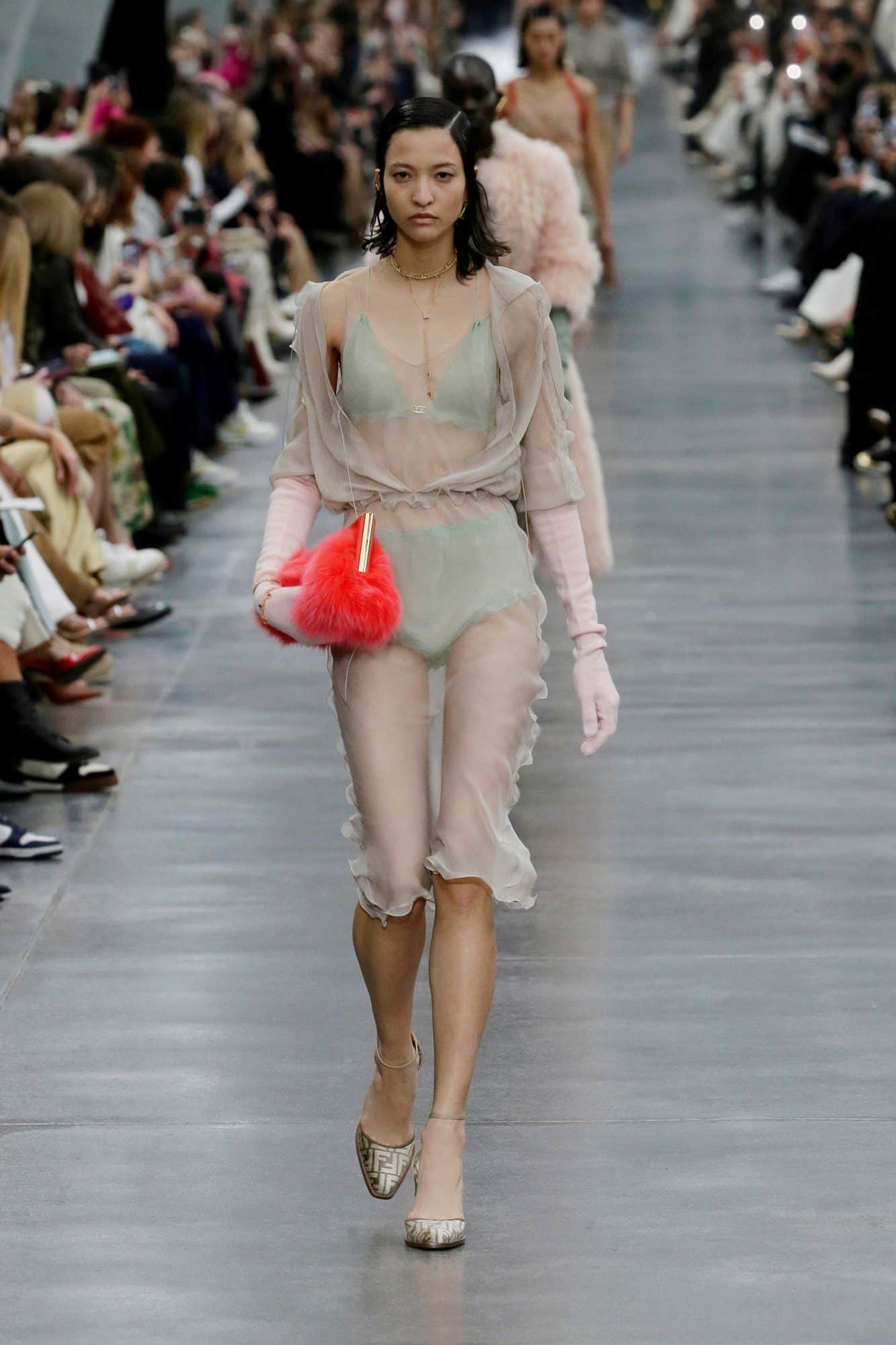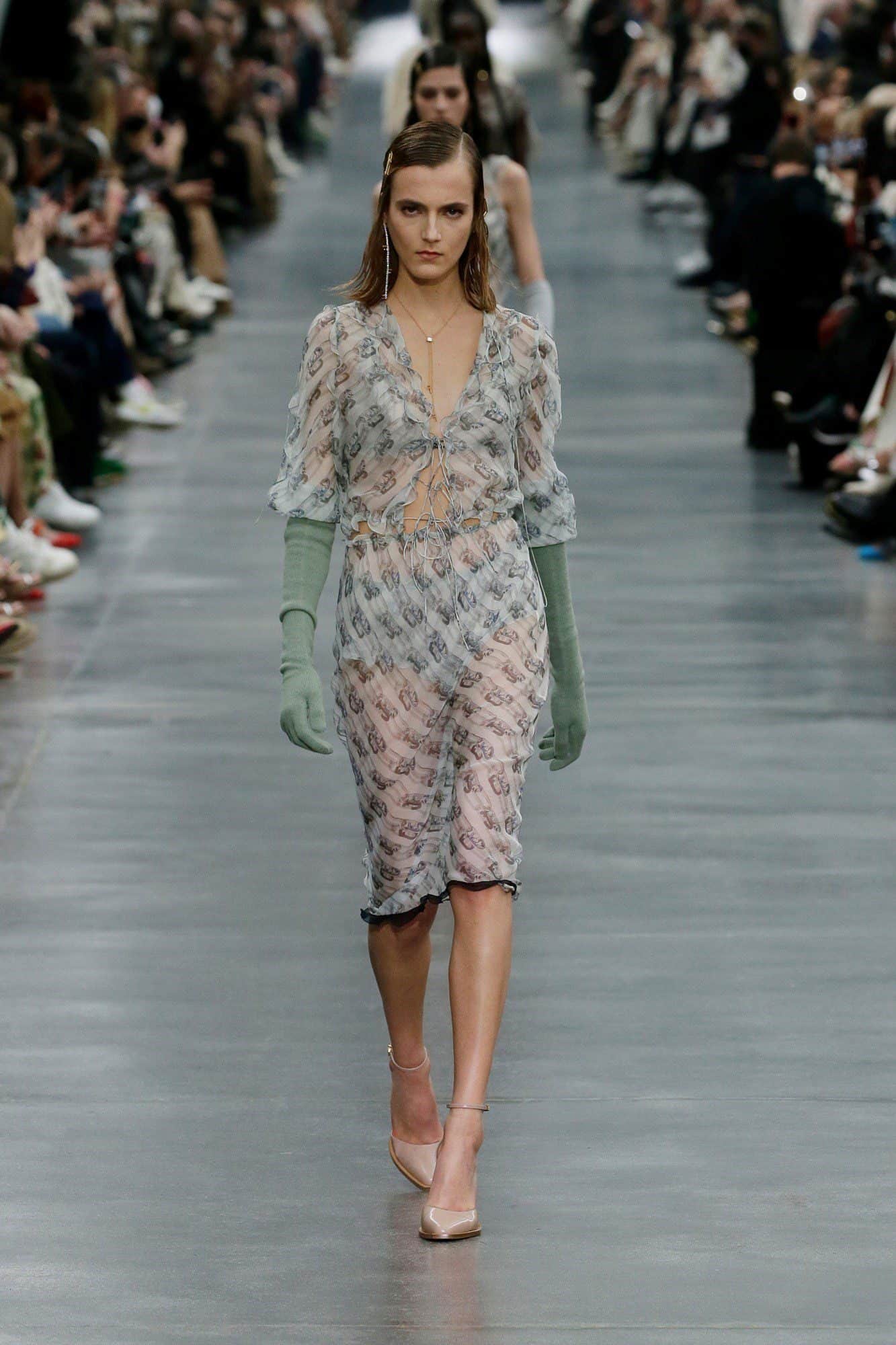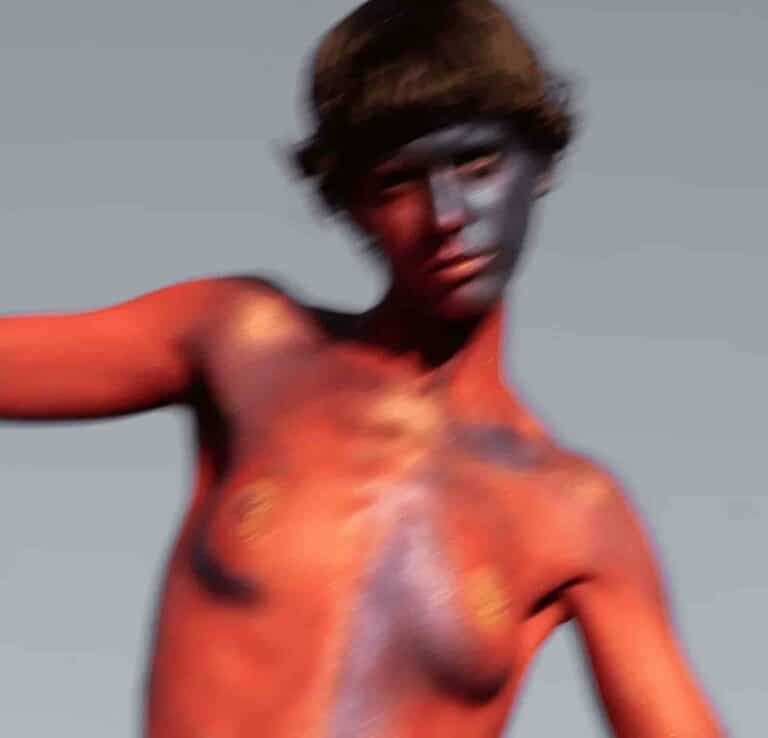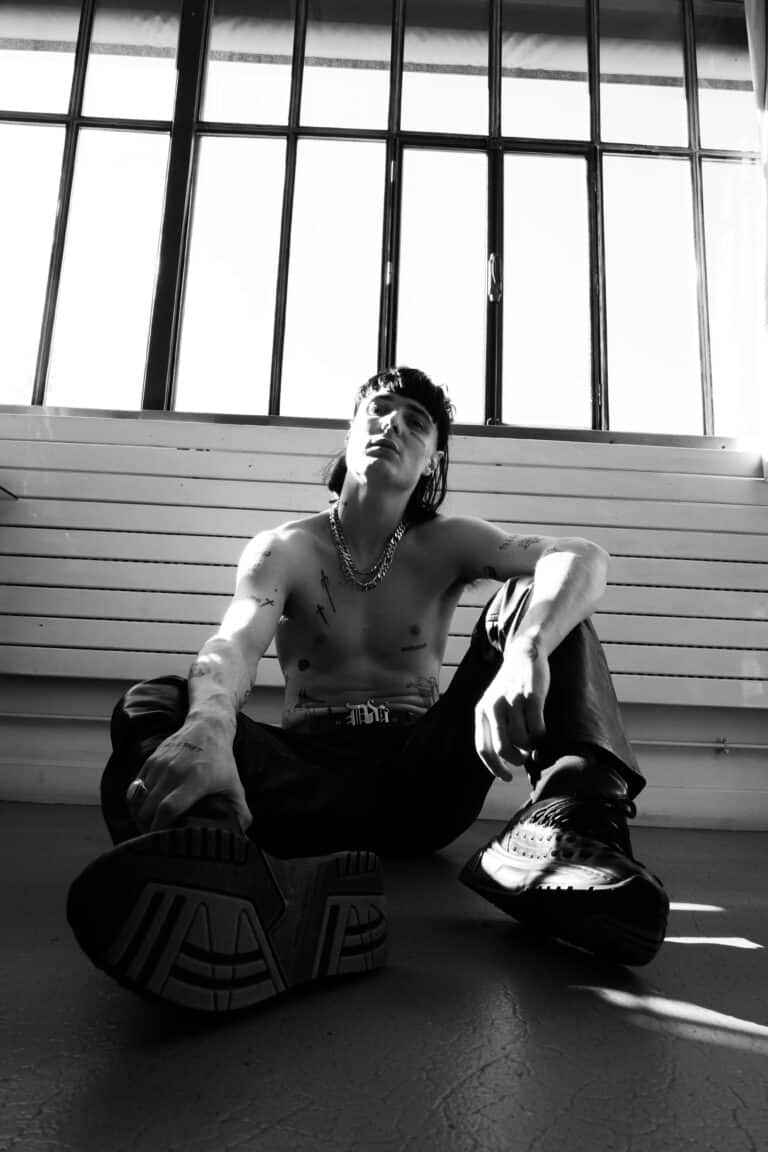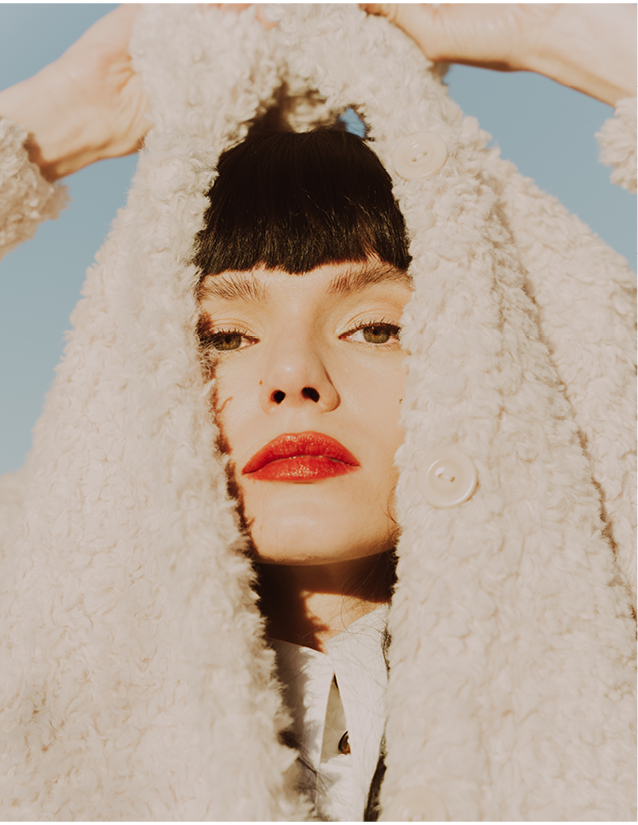It’s not often that a designer makes a pair of crystal earrings out of their own tears. “It was really a process of waking up really early in the morning, going to CSM, coming back late at night and then making myself cry [laughing] for however long,” commented fashion designer Matthew Needham. And it’s not often Alexander Mcqueen donates deadstock material, Sarah Mower offers up her old heels, and the model you chose turns out to be from the very town each look is inspired by – his stick and poke tattoo ‘Øyeblikk’ becoming the collection’s quirky title. But then again, there aren’t many designers like Matthew Needham.
Championing the beauty of upcycling and re-use, SLICK spoke to the sustainable designer about his new collection, keeping creative in lockdown, and how collecting tears for 2-3 months was more than emotionally draining.

Photography by Stopforth.
Slick: How did you come up with your MA collection’s title, ‘In the blink of an eye’?
Matthew: The name ‘In the Blink of an Eye’ is a translation from the Norwegian, word ‘Øyeblikk’. It’s a really funny story actually, the collection is only called that because I found this guy at CSM and asked him to model for me and it turns out that he’s actually from the same place in Norway that the collection is based on. When we were dressing and doing a fitting – this was like three months before the show – he had this stick and poke tattoo on his leg and it said ‘Øyeblikk’. I asked him what it means, and he told me, ‘you need to go, and have a look’. And when I found out it meant ‘in a blink of an eye’, or like a moment in time, I thought it was just perfect.
Slick: You showed your collection as a performance piece at the start of the CSM show, why did you choose to debut your collection this way?
Matthew: The collection was showcased in an installation-performance style format before the runway section of the show in February. Fabio had asked me to make a programme insert, and on the insert was a graphic display and an explanation of some of the garments the models were wearing. The idea was that the audience members would read through the sheet and the descriptions, and then go and find the [looks] when the model was wearing them and see which one was which. On each of the garments the description matches up as well, so there’s a small jersey square stitched to each of the garments, which explains why the garment exists as an artefact within the bigger story of Øyeblikk, and what it’s made of. It was amazing to do that, to showcase the collection in a more immersive way rather than it just being image based, and for the people who were really interested in understanding the collection a bit deeper. They had the time to do that, so it was a really great opportunity to do that.

‘The Wind Machine’, Central Saint Martins, November 2019.
Slick: Your collection is made up entirely of deadstock, I read on your INSTAGRAM that you’ve used everything from Alexander McQueen to suitcase components and Sarah Mower’s old heels. How would you describe your working process, and the importance of upcycling in the fashion industry?
Matthew: I’ve always found myself attracted to old things and old objects that have a history before I find them, and sort of give a new life to them. So the upcycling is just a natural progression of the way that I work, and the way that I see my work evolving. I told Sarah that I was upcycling some shoes with Helen Kirkham and that we needed some shoes to use as a base. We were trying to get in contact with McQueen to donate some shoes originally and it turned out they would donate some fabric to me, which was amazing! Sarah just turned to me and was like I’ve got so many old heels, do you want them? I was like, absolutely! That’s so much better than just some dedstock [laughing]. The story of those heels, how Sarah used to wear them to the shows in Paris and Milan and New York or whatever, it was sort of like an object from that side of the industry – that ‘fashion elitism’ part of the industry that we don’t feel like exists anymore – and then they’re upcycled with these vibrant five finger deadstock shoes that are made for hiking and walking outside. The narrative fed into that as well, the idea of being outside and in the wind, and walking up mountains, and the people in the collection going on this sort of journey. Me and Helen together combined the two concepts and brought them together in these heeled shoes which were great.
But with the importance in the industry, it’s something at the moment which is becoming more understood. People are starting to understand the language around upcycling and sustainability and re-use, where as three or four years ago when I did my BA at CSM, it wasn’t understood as much as it is now, and people kind of alientated me for it. It’s great that it’s more widely spoken about, but I feel as though the progress, or the progression from this time, would be the upcyclind and the recyclind becomes inherent within everyones work. I feel like it’s important for us as young creators to set that blueprint, and set the example for bigger brands to be doing it. The future generation of desginers at school, I think it’s really important for them to start learning about it at university which they are starting to do more. It’s extremely important, it’s just the way our future should be.

Photography by Stopforth.
Slick: It’s often thought that a design focus on sustainability limits creativity. Do you think it’s in fact the opposite?
Matthew: I feel as though having limits is a very good thing. It makes you push yourself as a creative, and having limitations – using objects that already exist in a form rather than a flat fabric – challenges you, it makes you question it more, it makes you push yourself, it makes you create interesting silhouettes that you otherwise wouodn’t have createed. So it depends how you look at it, certain people who grew up understanding a specific method of making in fashion would see it as a limit to their creativity, but I feel in fact as though it’s the opposite. Maybe not for everyone, but for me it is.
Slick: How would you describe your aesthetic?
Matthew: It really does change with the materials that I find, because they really do inform the identity of the body of work or collection I’m working on at the time. So my BA collection was a lot more gritty, it was a lot more dirty. I used a lot of stuff from my dad’s workshop, like wood and metal, that you wouldn’t really associate with fashion design. It’s about listening to the materials and seeing the possibility of making something from those materials – understanding their properties and values. But I guess there’s no newness to my aesthetic, for me to be abble to tell you where a specific object is from, date and time, there’s no more luxury than something that’s so unique to the wearer, that it just becomes so precious and so timeless.
Slick: What is your favourite concept or look from the collection?
Matthew: My favourite look from the collection is the one with the duvet dress, the one that Flo wore. The duvet dress was something that I randomly dreamt of one day, and I was working with Barnardos the charity (I worked with them a lot when I was doing the ‘DiscoMAKE Project’ with Fashion Revolution) and they have these tunnels underground in the Brixton one. This idea of being outside in Norway and camping with the duvet in the back of a car, or a sleeping bag in a tent or the woods or something, I feel as though that identity of that type of an object was just really interesting for me to work with. And even from the first experiment with the wind machine, the idea that the wind fills the shape out and creates these bigger silhouettes and structures, and also the identity of the duvet dress, there is a suggested way of wearing it, but in essence you can wear it any way you wish. It also is an object and an artefect that is questioned to be a garment to wear. And I really like that identity because it exists beyond the parameters of just something that you wear on your body, but also a functionable artefact that you can wear on the self that really tells the story of Øyeblikk.

Photography by Stopforth.
Slick: What were the biggest difficulties you came across in creating this collection?
Matthew: I mean the biggest difficulty is always time, because we have this system in fashion where we feel we have to churn out work every 4-6 months. The concept for his collection is much more personal than anything I’ve done before, it was really about self-exploration and so having to contain that concept within such a short time frame and really explore it as much as I could was very difficult. All of the garments were so individual and they all had seperate concepts and seperate parts to the collection that there was no sort of repetition, or nothing I could just repeat in a different colouor, or just make shorter or longer.
But also because it was so emotional to me, when we made The Tearing with Alice Potts, who is a bioscientist and material innovator, she grew crystals from my tears that I’d collected over the past 2-3 months and it was really a process of waking up really early in the morning, going to CSM, coming back late at night and then making myself cry [laughing] for however long. It’s a real emotional strain being at university anyway – and a physical strain – but just having that extra emotional task was extremely difficult but worth it in the end.
Slick: And the best memories?
Matthew: Great memories were spent with Bethany Williams in her studio, she let me use it a lot, purely because I had so much stuff. When you’re upcycling you tend to accumulate a lot of crap, so it was difficult to keep it in the CSM studio without being told off [laughing]. So that was amazing, to be around Beth a lot and discuss things. My helpers Carlota and Jacob were amazing as well. The show day was incredible, bringing all the people I love to the show and all the contributors being able to see it was just a great feeling.

Photography by Stopforth.
Slick: Talk us through the glass balloon headpiece and the crystal made out of your own tears! What inspired these pieces and what do they mean to you?
Matthew: The collection is really about a self reflection of a period of time within my own life that really changed the way that I see the world. It was a period that ended about three years ago, and I was going to Norway a lot, because my ex boyfriend was from Norway. Seeing the mountains and the sea and the environment in that way, I’d never experienced the world like that, and it really changed my whole view of why I make clothing and the impact that can have beyond the parameters of it being a ‘collection’. It’s also about how it influences people, and how you can really say something that’s important through the work and through the collection. This particular collection was about transporting myself back to that period, mentally, and trying to understand why what happened when it ended, and how it affects me now, and how I feel about it now, and how I’ve grown as a person having experienced that.
So the tear crystal – The Tearing we called it. I reached out to Alice, November last year – we’ve been friends for a couple of years – and I asked her if she’d ever grown crystals from tears, because I knew about her work with sweat. What was so interesting is that she had never made crystals out of tears before, but she told me that the genetic make up of the tears is different when you’re happy, to when you’re sad. So if you cry when you’re sad, it looks different under a microscope to when you cry when you’re happy, or if you’re cutting onions or something. I think we’re both so fascinated with this idea, that if I was to cry thinking about this time, or thinking about how I felt internally about, you know, going back to Norway mentally or, you know, working on this collection, it was a true embodiment of that time or emotion inside an object, an inanimate object. And it became the centrepiece to the collection. So I created the shape in sort of a wire, and it was inspired by the suitcase wires used in the collection, there’s a sort of body sculpture as well as always wearing in one of the looks, which is in fact, the suitcase wire. And then a jeweller friend of mine, Terry Paul, he created this exact same shape in silver. Two crystals formed as well, we didn’t actually know what was going to happen and she just sort of did it in their kitchen. And I collected them over a two month period in a film canister.
With the balloon headpiece, I met Joe through a friend called Leo Carlton who’s also a milliner. And what’s so great about Joe is that we’re both so process based as designers, and we’re both very attracted to materials and found things. We always wanted to work together on something, we sort of tried before, but this felt like the right time. And I came to Joe with the idea of this glass balloon headpiece, or originally we wanted it to be in glass, but due to the time restrictions, we made it in non-toxic resin, and the significance of the balloon I’ll keep to myself. But she actually coincidentally was working with balloons at that time as well. So it just felt so strange but so perfect. And her work with resin. She’s worked with resin quite a lot and she’s sort of mastered the skill of working with resin which is exciting. Dreamy, difficult, and it’s amazing what she can do. And so together, we sort of created this process where she hung the balloons from the stools in her studio, and then I would come and we would like talk through it and see how it went to like put it on the head or position it. The other pieces sort of fed from the balloon headpiece, and that was sort of the water balloon, which was this water vessel held by another one of the guys in the show and the mouthpiece as well, which was a shard of resin that had come off of the sculpture and we just sort of made it on the day of the show with a headphone wire. So it was right up until the end. I think that’s something that’s normally occurs with my process. It never ends until you know the show or even after, and there might be still pieces that I add after the show.

Øyeblikk Presentation, Central Saint Martins.
Slick: How did you keep creative in self-isolation?
Matthew: I think lockdown has been extremely difficult for a lot of young creatives – financially and mentally. Not being able to be outside, not being able to be in the world and be inspired, and see things, and experience new things. For me in the beginning, it was extremely difficult and moving everything here from CSM and just not really having a purpose at that time. All of the freelance jobs had been cancelled, which is the same for a lot of people.
But in the last couple of months, it’s been great to get back in contact and start more of a structure again with my friends and companies. It was great to work on a film for the London Fashion Week online platform. I released a song with my sister, it’s called In The Blink Of An Eye and we wrote it when the collection was being made. It accompanied the film, which was just an accumulation of snippets of video clips on my phone from making the collection to flying to Norway, to the experiments and filming the photographs of the garments floating. It re-motivated me, but I feel like now as everything’s opening up again, it feels much more positive and fresh. And obviously, it’s going to take a while for us to get back to normal, whatever that means. But I think it’s also been healthy, if you look at it in a positive way, because never have we had the opportunity or been forced to slow down and forced to think about what it is we do and the purpose as to why we do it. And it’s really made me reflect as well as as a designer, on how my work can influence the world in an even more positive way and what I want to do moving forward from this.
Slick: Who would be your favourite character/celebrity/actor to wear Matthew Needham?
Matthew: So what was amazing is that I had the opportunity last year to dress Emma Watson for the Pirelli Calendar, it was a shot by Paolo Roversi and styled by my friend IB KAMARA. And Ib kind of gave me the brief of this idea of searching for Juliet, it was a very fast turnaround as well. We only had five days to make this sort of dishevelled cotton gown. But I might actually say that I would love to dress Lady Gaga, I mean I grew up with LADY GAGA, and it’s always been a dream to meet her. If your views align with the views of the the celebrit, that’s very important for me. To make sure that they really do understand why you’re making it, or what it’s made from, or how it’s made and not just because it looks really pretty.
Slick: What’s next for Matthew Needham?
Matthew: What’s next? I actually don’t know, and I think that’s probably the answer that a lot of people would give right now. It’s given me time being locked down, like I said, to reflect on what I want to do, and why I want to do it, and how to explain it properly. And I mean, just trying to find some more work, work on freelance stuff again, carry on teaching and just slowly but surely get back to this idea of “normal”. The world is full of endless possibilities. And in a year’s time, who knows what’s going to happen? It’s quite exciting though really, isn’t it?
Photography by Stopforth Studio, All Clothing Matthew Needham, All Footwear Matthew Needham X Helen Kirkham, All ‘Glass’ Pieces Matthew Needham X Joe Miller, Make Up Mattie White, Hair, Mike O’gorman.


